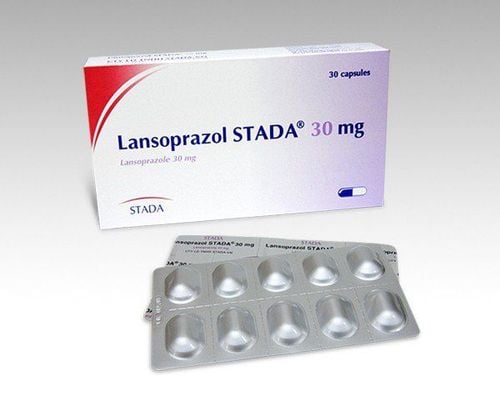This is an automatically translated article.
The article was professionally consulted by Specialist Doctor I Dang Thi Ngoc Chuong - Department of Pediatrics - Neonatology, Vinmec Central Park International General Hospital. He used to work at Children's Hospital I, Thu Duc Hospital and University of Medicine and Pharmacy Hospital in Ho Chi Minh City, with strengths in neonatal diagnosis and examination - neonatal resuscitation.
9-month-old children vomit, lazy to eat can lead to malnutrition, affecting the baby's brain development, reflexes and absorption. In addition, weak resistance is an opportunity for bacteria to easily penetrate and cause disease, making the baby more anorexic and slow to gain weight.
1. The phenomenon of vomiting in children
Vomiting is a phenomenon in which the contents of the stomach are pushed back through the mouth due to physical exertion. Vomiting occurs after a baby has had a full meal, food or milk will come out of the mouth after each sudden movement or position change.
Usually, vomiting in weaning-age children is a manifestation of a number of digestive diseases such as gastroesophageal reflux, which can be a symptom of a respiratory disease or a systemic disease, ....
Vomiting in children is divided into 2 types: physiological regurgitation and pathological regurgitation.
Physiological vomiting: After birth, because the baby's stomach is still small and horizontal, it is easy for the baby to vomit. After 8-9 months of age, physiological regurgitation will disappear. Pathological regurgitation: In the case of pathological regurgitation, children often have symptoms of fever, convulsions, accompanied by fever, cough, rash, writhing abdominal pain, abdominal distension... In this case, mother Pay attention and take your child to the doctor because it is possible that the child is suffering from an illness such as a stomach infection, food poisoning, or meningitis, appendicitis, bacterial infection, viral infection, pyloric stenosis, intussusception. intestines, gastric motility disorders, esophagus.

Nôn trớ ở trẻ
2. What to do when a 9-month-old child vomits?
Currently, there are many cases of 9-month-old children vomiting, which affects their health. Therefore, taking care of a 9-10 month old baby is extremely important.
When the child is showing signs of vomiting food or milk, take a clean towel to wipe the child's mouth and put a towel around his neck to prevent further vomiting. Do not pick up the child while vomiting because it increases the risk of vomiting fluid into the lungs. Do not yell or show anger that easily makes the child lose his temper, fuss and spit more. You need to talk softly so that the child can forget about the vomiting, and stroke the chest and back for the child from the top down. Put the child to lie still, need to raise the head, and always keep the upper body higher than the bottom to avoid reflux. When the baby vomits a lot of milk, it is advisable to lie on his side to avoid aspiration of vomit into the lungs. Mothers also need to remember not to give milk to babies immediately after vomiting. In addition, it is necessary to quickly wipe the child's face and mouth, change his clothes, and rinse his mouth to avoid unpleasant odors caused by vomit. When vomiting, children lose a lot of water as well as electrolytes. Therefore, the necessary measure at this time is to supplement to replace the amount of water and electrolytes for the child. You can use Oresol solution, salted porridge or diluted fruit juice.
Note when using Oresol to rehydrate and electrolytes for children, mothers need to pay attention to mixing according to the manufacturer's instructions, giving them little by little and not mixing from morning to afternoon. children drink.
3. Measures to reduce vomiting for 9-month-old children
Once she has the knowledge about regurgitation and how to handle it, the mother should have a nutritional regimen for the 8-9 month old baby to limit the child's regurgitation.3.1 For breastfed babies Mother should feed the baby slowly, not to overfeed and only let the baby lie down after breastfeeding for at least 15 minutes. When breastfeeding, the mother needs to hold the baby's head and the baby lying in a straight line, facing the breast, the baby's nose facing the nipple.

Các biện pháp giảm nôn trớ cho trẻ 9 tháng tuổi
The mother has to hold the child close to her body and use her hands to support the buttocks. Then, touch the breast to the baby's upper lip, wait until the baby's mouth is wide open, then bring the baby's mouth to the breast so that the baby's lower lip is below the nipple.
Should feed the baby on the left side first (the baby has just sucked, so the amount of milk in the stomach is still small, can lie on the right side). At this time, turn the baby to the right (because the baby's stomach is full of milk, need to lie on the left side) so that the milk will easily circulate without causing reflux.
After feeding the baby, you need to stand up and pat the baby's back so that the baby can burp. This helps reduce the amount of gas that the baby swallows into the stomach, which is also the cause of vomiting.
3.2 For bottle-fed babies Mothers need to tilt the bottle to feed the baby, so that the milk is submerged in the neck of the bottle to avoid swallowing air into the stomach causing vomiting.
3.3 With weaning babies When babies are just learning to eat solid foods, mothers should not force them to eat a lot, which can make them scared when they see food.
Instead, you can divide food into many small meals throughout the day to ensure enough food needed. Children's meals should be concentrated and the eating time should not last more than 30 minutes/meal. Eating for too long can easily make children tired, over time, it will cause a feeling of loss of appetite, making children cry and disturb.
For children who cannot tolerate raw cow's milk, soy milk or cow's milk in the form of yogurt can be substituted. In the case of children with prolonged anorexia, malabsorption, and growth retardation, parents should supplement children with supportive products containing lysine, essential micro-minerals and vitamins such as zinc, chromium, selenium, and B vitamins. help meet the nutritional needs of children. At the same time, these essential vitamins also support digestion, enhance nutrient absorption, help improve anorexia, and help children eat well. Parents can simultaneously apply dietary supplements and functional foods derived from nature for easy absorption. The most important thing is that improving your baby's symptoms often takes a long time. Combining many types of functional foods at the same time or changing many types in a short time can make the baby's digestive system unable to adapt and completely not good. Therefore, parents must be really patient with their children and regularly visit the website vimec.com to update useful baby care information.














